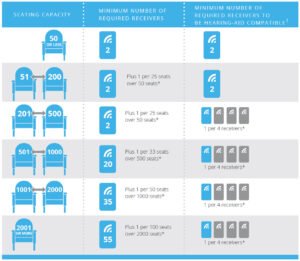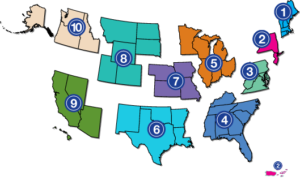Americans with Disabilities Act (ADA) Standards

Below are key Assistive Listening System excerpts from the Americans with Disabilities Act (ADA): when required, graphics, providing notice, owner responsibilities, and equipment.
Four Assistive Listening Systems, as recognized by the ADA
- Hearing loop
- FM System, also RF System
- Infrared System
- Direct-wired equipment (very uncommon)

Where Will You Find Assistive Listening Systems?
The following places should have a hearing loop, FM system, or infrared system:
- In ALL indoor or outdoor areas or rooms, with a public address system. These are called “Assembly Areas.“
- In all Courtrooms
- Where Effective Communication is needed, such as service counters, rooms without public address systems, etc.
Assistive Listening Systems apply to: Title I (employment), Title II entities (state and local governments), and Title III entities (businesses and nonprofit organizations that serve the public).
See a list of the Types of Places REQUIRED to Have Assistive Listening Systems (this website)
Signage
All assistive listening systems need a sign with the International Symbol of Access for Hearing Loss.
Graphics are available (this website)
Tactile requirements, ADA (webpage)

Entities are Responsible
Title II and Title III entities cannot ‘farm out’ their assistive listening system ADA responsibilities.
Provide Public Notice
Title II entities. “Public entities are required to ensure that interested people, including people with vision or hearing impairments, can obtain information as to the “existence and location of accessible services, activities, and facilities.” This is an important but frequently overlooked part of the regulations.”
“To ensure that the public can easily identify the ADA Coordinator, the person’s name and contact information must be provided to the public.”
from ADA Action Guide (webpage)
For Title III entities, public notice is a best practice, but not required. However, it helps both the site and the public to provide advanced information on what accommodations are already available. That way, the owner/operators don’t answer the same questions over and over, and users can plan to attend or request something else they might need.
Receivers Required
Online Receiver Calculator. Receiver calculator Northwest ADA Center (webpage). Please see resources below for more details.
Effective Communication
The ADA requires that title II entities (State and local governments) and title III entities (businesses and nonprofit organizations that serve the public) communicate effectively with people who have communication disabilities. The goal is to ensure that communication with people with these disabilities is equally effective as communication with people without disabilities.
- The purpose of the effective communication rules is to ensure that the person with a vision, hearing, or speech disability can communicate with, receive information from, and convey information to, the covered entity.
- Covered entities must provide auxiliary aids and services when needed to communicate effectively with people who have communication disabilities.
- Aids and services include a wide variety of technologies including 1) assistive listening systems and devices; 2) open captioning, closed captioning, real-time captioning, and closed caption decoders and devices; 3) telephone handset amplifiers, hearing-aid compatible telephones, text telephones (TTYs) , videophones, captioned telephones, and other voice, text, and video-based telecommunications products; 4) videotext displays; 5) screen reader software, magnification software, and optical readers; 6) video description and secondary auditory programming (SAP) devices that pick up video-described audio feeds for television programs; 7) accessibility features in electronic documents and other electronic and information technology that is accessible (either independently or through assistive technology such as screen readers).
Resources
Great Lakes ADA Center – Accessible Technology Webinar Series
“Assistive Listening Systems: Where We Are Today and What’s On The Horizon”
When an elevator is installed, no one asks why the elevator is needed or how to use it. In comparison, when an assistive listening system (ALS) is installed, almost everyone will say “Huh?”
In these sessions, you’ll learn that even when people wear hearing aids, they still need assistive listening systems to hear clearly in public and private entities. The session will cover which systems fall under the Americans with Disabilities Act (ADA), the ADA standards, the practicality of the different ALS, and best practices for managers so that users have a positive experience, whether they wear hearing devices or not. Also, the session will cover how Auracast may be used as an assistive listening system with International Electrotechnical Commission (IEC) standards to be released in 2027. For years to come, all assistive listening systems will coexist for users to access clear speech anywhere they go.
- Part 1: Foundation (webpage). Thursday, May 16, 2024. 90 minutes, recorded webinar (webpage). Topics: About hearing loss, Assistive listening systems overview, ADA Standards and Requirements, Telecoils
- Part 2: Real World (webpage). Thursday, July 18, 2024. 90 minutes, recorded webinar (webpage). Topics: Hearing Loops, FM/RF Systems, Infrared Systems, ADA Signage, Best Practices, Audio Over Wi-Fi, Auracast Broadcast Used as an Assistive Listening System, System Comparison, Coexistence Today and in the Future
Timing
- Part 1: Foundation (webpage). Thursday, May 16, 2024. 90 minutes, recorded webinar
- 1:53 Start/outline of session
- 5:10 About hearing loss
- 15:54 Assistive listening systems overview
- 28:07 ADA Standards and Requirements – Effective Communication and Assistive Listening Systems
- 46:56 Telecoils
- 57:20 ADA Standards – table for receivers, public notice, transition plans
- 1:11 Q&A
- Part 2: Real World (webpage). Thursday, July 18, 2024. 90 minutes, recorded webinar
- 1:52 Start/outline of session
- 4:20 Assistive Listening Systems – ADA
- 6:11 Hearing Loops
- 26:23 FM/RF Systems
- 37:20 Infrared Systems
- 42:24 ADA Signage
- 47:40 Best Practices
- 55:43 Audio Over Wi-Fi
- 59:33 Auracast Broadcast Used as an Assistive Listening System
- 1:10:25 System Comparison, Coexistence Today and in the Future
#1 If the assembly area has a public address system or is a courtroom: ADA Standards for Accessible Design (at www.ada.gov website) requires an assistive listening system.
- Accessible Design (webpage, see sections 216, 219, 703, 706, 904)
- Signs (webpage, US Access Board, chapter 7)
- ADA Standards for Assistive Listening Systems Summary HLAA (4-pages, pdf)
#2 If hearing assistance is needed for the situation, Title II and Title III entities still need to provide auxiliary aids and services so you can equally participate.
- Effective Communication (webpage)
- Effective Communication Fact Sheet (webpage)
- About Effective Communication (NE ADA Center, webpage)
ADA Title II
- Action Guide for State and Local Governments (webpage)
- ADA Self-Evaluation – Effective Communication (pdf)
Law Enforcement
- Communicating with People Who Are Deaf or Hard of Hearing – ADA Guide for Law Enforcement Officers (webpage)
- Model Policy for Law Enforcement on Communicating with People Who are Deaf or Hard of Hearing (webpage)
- Title II. § 35.130 General prohibitions against discrimination.
(b) (1) A public entity, in providing any aid, benefit, or service, may not, directly or through contractual, licensing, or other arrangements, on the basis of disability—(i) Deny a qualified individual with a disability the opportunity to participate in or benefit from the aid, benefit, or service… ADA Title II Regulations
- Title III. § 36.202 Activities.
(a) Denial of participation. A public accommodation shall not subject an individual or class of individuals on the basis of a disability or disabilities of such individual or class, directly, or through contractual, licensing, or other arrangements, to a denial of the opportunity of the individual or class to participate in or benefit from the goods, services, facilities, privileges, advantages, or accommodations of a place of public accommodation. ADA Title III Regulations
For hearing loops. Since the telecoil in hearing aids is the receiver, no “hearing aid compatible receivers” are needed (3rd column).
Three ways to calculate:
- Use the “Table 219.3 Receivers for Assistive Listening Systems” which also has the footnote for multiple rooms. ADA Standards
- Online Receiver calculator Northwest ADA Center (website)
- Use the graphic. Click on graphic for a better image. Graphic courtesy of Listen Technologies
- ADA Regional Centers (website). The National Network of ADA Centers provides information, resources, and trainings for consumers, organizations, and businesses, but do not have enforcement responsibilities.
- U.S. Access Board, Technical Assistance (website with contact info)
Map of 10 Regional ADA Centers
- National Disability Rights Network Federally mandated Protection and Advocacy (P&A) Systems and Client Assistance Programs (CAP)
- Job Accommodation Network (JAN) is the leading source of free, expert, and confidential guidance on job accommodations and disability employment issues
- State Vocational Rehabilitation. Support and resources for accommodations and assistive technologies on the job.
Multiple Countries
- Legislation and building regulations. 2018. (Ampetronic manufacturer, 8 pages, pdf)
- Global Disability Legislation. 2021. (Williams AV, 9 pages, pdf)
ISCVE (United Kingdom) Institute of Sound, Communications and Visual Engineers Ltd
- Overview A Guide and a Code of Practice for Assistive Listening Systems (webpage). This Guide and Code of Practice have been published by the ISCVE to help venue managers, installation companies and users of Assistive Listening Systems.
- Document #1: ISCVE Guide Assistive Listening Systems (10 pages)
- Document #2: ISCVE Code of Practice for the Design and Operation of Assistive Listening Systems (66 pages)


